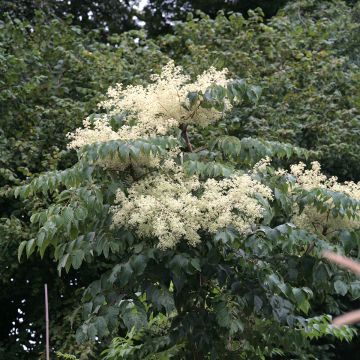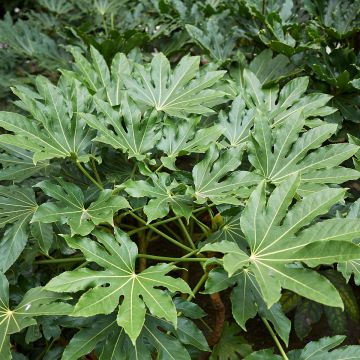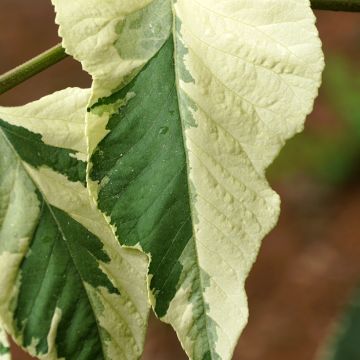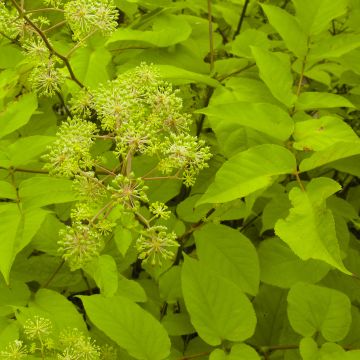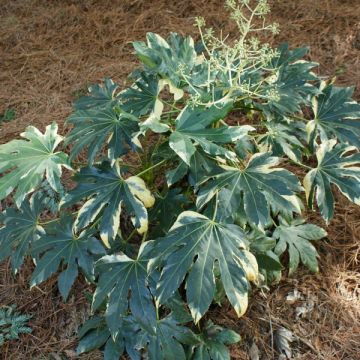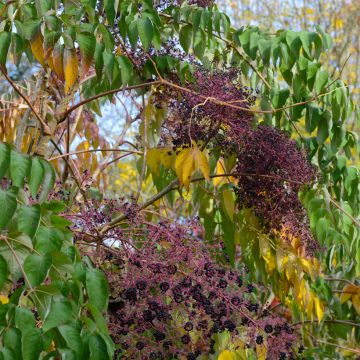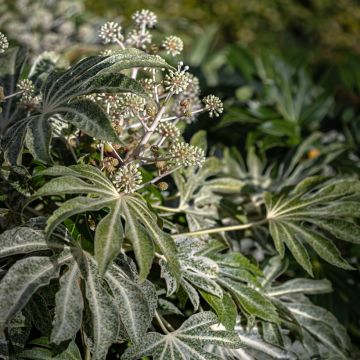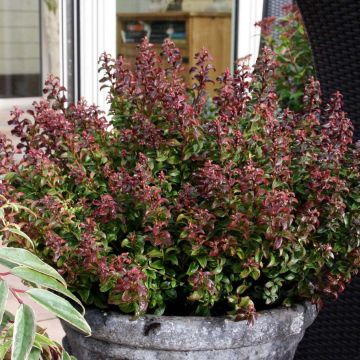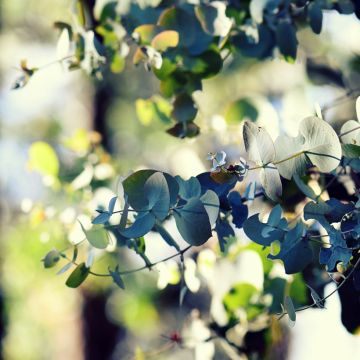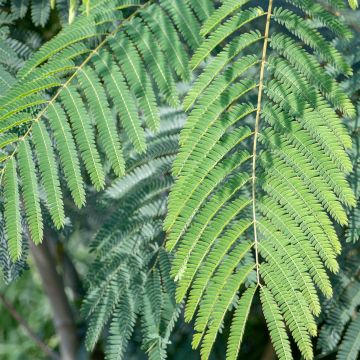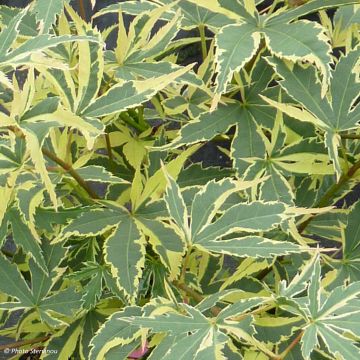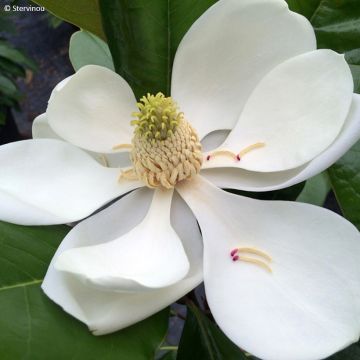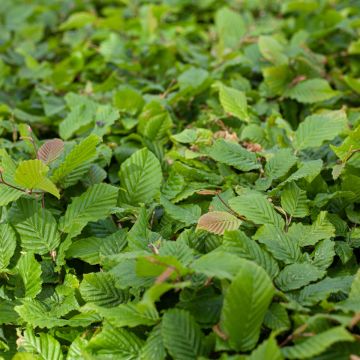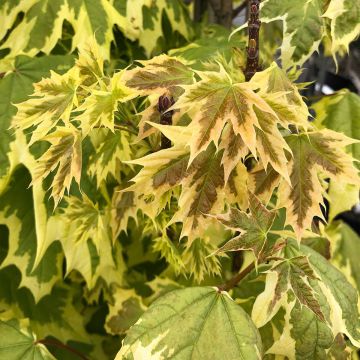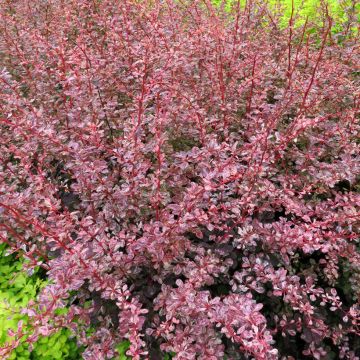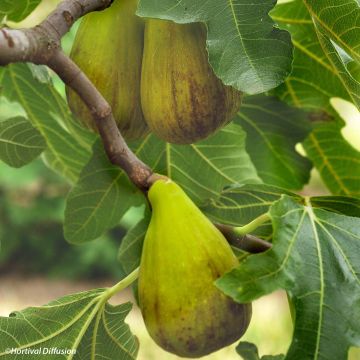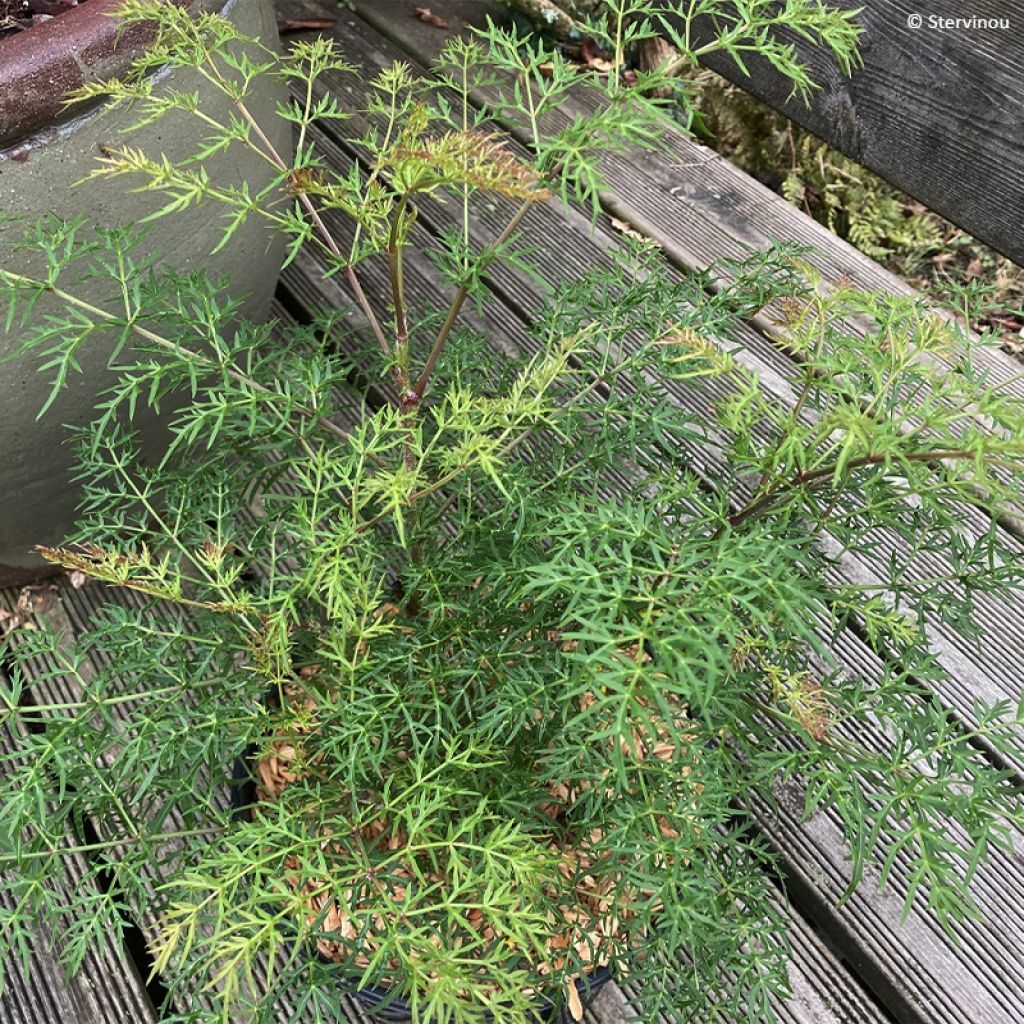

Polyscias sambucifolia - Sureau panax
Polyscias sambucifolia
Polyscias sambucifolia
Victorian Elderberry Ash, Elderberry Panax
This item cannot be shipped to the selected country
Delivery charge from €5.90
More information
Schedule delivery date,
and select date in basket
This plant carries a 24 months recovery warranty
More information
We guarantee the quality of our plants for a full growing cycle, and will replace at our expense any plant that fails to recover under normal climatic and planting conditions.
From €5.90 for pickup delivery and €6.90 for home delivery
Express home delivery from €8.90.
Does this plant fit my garden?
Set up your Plantfit profile →
Description
Polyscias sambucifolia, also know as Elderberry Panax, is a beautiful evergreen shrub from Australia that is still rare in cultivation but deserves to be discovered. It forms a wide and bushy mass of green-grey foliage, that is more or less finely cut, and produces an abundance of greenish flowers in panicles, and then small edible fruits which are almost translucent and a bluish-purple in colour. Not very hardy (-8°C), this plant can be grown in the ground in milder regions, or in a large pot to be overwintered in harsher climates.
Polyscias sambucifolia belongs to the Araliaceae family, it is a relative of Aralia and Pseudopanax. It is a species found in the southern part of eastern Australia, where there is a mild and more or less humid oceanic climate. The appearance of this shrub can vary depending on its habitat, the sambucifolia species has recently been divided into three subspecies (sambucifolia, decomposita, and leptophylla) characterised by its growth and finely cut foliage. In nature, this shrub is often found on the edge of woodland.
The Elderberry Panax, is fast-growing, and can reach 3.50 m (11ft) in height and 2.50 m (8ft) in width in the ground, or even more in favourable conditions. Its dimensions will be more modest when grown in a pot. The trunk is straight, covered with dark brown to black bark, marked with small blister and ridges. Its habit is both spreading and erect, with dense and branched vegetation from the base of the trunk. Some plants produce suckers, especially the high-altitude subspecies, accentuating the bushy appearance of the plant. The foliage persists in winter. It consists of pinnate leaves measuring 5 to 30 cm (2 to 12in) long, with up to 5 pairs of leaflets. These leaflets, which are ovoid to broadly elliptical in shape, measure 9 to 20 cm (4 to 8in) long and 3 to 17 mm (1in) wide. Their colour is a more or less greyish green-blue. Flowering takes place between May and July in our climate (from November to February in Australia). The flowers, although appearing in large clusters, are pale green and insignificant. However, once pollinated, they give rise to small decorative and edible berries, 4 mm (1in) in diameter, with a very soft bluish-purple colour that becomes translucent when ripe. These fruits are edible.
It is a beautiful shrub that prefers the coastal region of our country and partial shade. It adapts to well-drained moist, and not too dry, soils, which aren't too sandy. Its decorative foliage deserves to be protected from strong winds to preserve its beauty. Once established, it is superb as a specimen plant or in a group. Polyscias sambucifolia is also interesting in association with exotic bushes that, like itself, appreciate moist to wet soils, such as Fargesia bamboos, Aaralias, and elderberries, for example. It can also be grown in a container or a large pot, to be overwintered like a citrus tree.
Report an error about the product description
Plant habit
Flowering
Foliage
Botanical data
Polyscias
sambucifolia
Araliaceae
Victorian Elderberry Ash, Elderberry Panax
Australia
Other Aralia
Planting and care
Polyscias sambucifolia appreciates a semi-shaded position, or morning sun, to avoid scorching sunlight. It is important to plant it with shelter from strong or drying winds to spare its ornamental foliage. It thrives in slightly moist to wet, fertile soil, which is slightly acidic to slightly alkaline and well-drained. Sandy soils are not suitable for this plant. This small tree sometimes tends to sucker, without being invasive. It is sufficient to remove the small suckers as soon as they appear near the stump. The stump can withstand short cold spells to -8°C (17.6°F) with protection. Well-established specimens are always more resistant than recently planted young plants.
Pot cultivation: choose a large size pot, with drainage holes and a drainage layer (clay balls, pottery shards...). Use a mixture of horticultural compost and garden soil. The growing substrate should never completely dry out but do not allow it to become waterlogged (do not leave a saucer full of water under the pot). In spring, apply a slow-release organic fertilizer specifically for flowering bushes.
Planting period
Intended location
Care
This item has not been reviewed yet - be the first to leave a review about it.
Striking foliage shrubs
Haven't found what you were looking for?
Hardiness is the lowest winter temperature a plant can endure without suffering serious damage or even dying. However, hardiness is affected by location (a sheltered area, such as a patio), protection (winter cover) and soil type (hardiness is improved by well-drained soil).

Photo Sharing Terms & Conditions
In order to encourage gardeners to interact and share their experiences, Promesse de fleurs offers various media enabling content to be uploaded onto its Site - in particular via the ‘Photo sharing’ module.
The User agrees to refrain from:
- Posting any content that is illegal, prejudicial, insulting, racist, inciteful to hatred, revisionist, contrary to public decency, that infringes on privacy or on the privacy rights of third parties, in particular the publicity rights of persons and goods, intellectual property rights, or the right to privacy.
- Submitting content on behalf of a third party;
- Impersonate the identity of a third party and/or publish any personal information about a third party;
In general, the User undertakes to refrain from any unethical behaviour.
All Content (in particular text, comments, files, images, photos, videos, creative works, etc.), which may be subject to property or intellectual property rights, image or other private rights, shall remain the property of the User, subject to the limited rights granted by the terms of the licence granted by Promesse de fleurs as stated below. Users are at liberty to publish or not to publish such Content on the Site, notably via the ‘Photo Sharing’ facility, and accept that this Content shall be made public and freely accessible, notably on the Internet.
Users further acknowledge, undertake to have ,and guarantee that they hold all necessary rights and permissions to publish such material on the Site, in particular with regard to the legislation in force pertaining to any privacy, property, intellectual property, image, or contractual rights, or rights of any other nature. By publishing such Content on the Site, Users acknowledge accepting full liability as publishers of the Content within the meaning of the law, and grant Promesse de fleurs, free of charge, an inclusive, worldwide licence for the said Content for the entire duration of its publication, including all reproduction, representation, up/downloading, displaying, performing, transmission, and storage rights.
Users also grant permission for their name to be linked to the Content and accept that this link may not always be made available.
By engaging in posting material, Users consent to their Content becoming automatically accessible on the Internet, in particular on other sites and/or blogs and/or web pages of the Promesse de fleurs site, including in particular social pages and the Promesse de fleurs catalogue.
Users may secure the removal of entrusted content free of charge by issuing a simple request via our contact form.
The flowering period indicated on our website applies to countries and regions located in USDA zone 8 (France, the United Kingdom, Ireland, the Netherlands, etc.)
It will vary according to where you live:
- In zones 9 to 10 (Italy, Spain, Greece, etc.), flowering will occur about 2 to 4 weeks earlier.
- In zones 6 to 7 (Germany, Poland, Slovenia, and lower mountainous regions), flowering will be delayed by 2 to 3 weeks.
- In zone 5 (Central Europe, Scandinavia), blooming will be delayed by 3 to 5 weeks.
In temperate climates, pruning of spring-flowering shrubs (forsythia, spireas, etc.) should be done just after flowering.
Pruning of summer-flowering shrubs (Indian Lilac, Perovskia, etc.) can be done in winter or spring.
In cold regions as well as with frost-sensitive plants, avoid pruning too early when severe frosts may still occur.
The planting period indicated on our website applies to countries and regions located in USDA zone 8 (France, United Kingdom, Ireland, Netherlands).
It will vary according to where you live:
- In Mediterranean zones (Marseille, Madrid, Milan, etc.), autumn and winter are the best planting periods.
- In continental zones (Strasbourg, Munich, Vienna, etc.), delay planting by 2 to 3 weeks in spring and bring it forward by 2 to 4 weeks in autumn.
- In mountainous regions (the Alps, Pyrenees, Carpathians, etc.), it is best to plant in late spring (May-June) or late summer (August-September).
The harvesting period indicated on our website applies to countries and regions in USDA zone 8 (France, England, Ireland, the Netherlands).
In colder areas (Scandinavia, Poland, Austria...) fruit and vegetable harvests are likely to be delayed by 3-4 weeks.
In warmer areas (Italy, Spain, Greece, etc.), harvesting will probably take place earlier, depending on weather conditions.
The sowing periods indicated on our website apply to countries and regions within USDA Zone 8 (France, UK, Ireland, Netherlands).
In colder areas (Scandinavia, Poland, Austria...), delay any outdoor sowing by 3-4 weeks, or sow under glass.
In warmer climes (Italy, Spain, Greece, etc.), bring outdoor sowing forward by a few weeks.


































